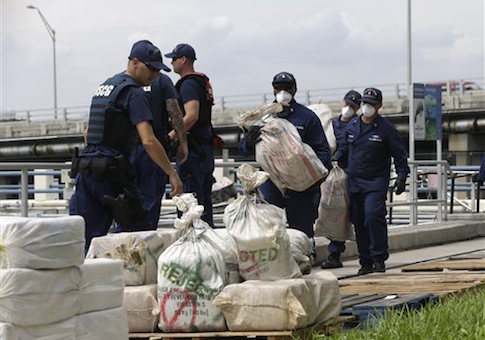The level of cocaine intercepted by the U.S. Coast Guard in 2015 rose by more than 50 percent due to an extreme increase in total cocaine flow into the United States, according to a new Department of Homeland Security report; the increase in cocaine smuggling has continued despite millions of dollars spent by the U.S. government to reduce the number of shipments flowing into the country.
The total flow of cocaine into the United States via a seven million square mile shipping lane known as the Transit Zone increased by 309 metric tons over the past year, bringing the total 2015 level of shipped cocaine to 1,254 metric tons, the report found.
The Coast Guard failed to meet its performance targets for the year despite the record amount of cocaine being shipped and intercepted, according to the report, which notes that the patrol force will have even fewer resources in 2016 to carry out its anti-drug mission.
"The known cocaine flow through the Transit Zone via non-commercial means increased in FY 2015 to 1,254 metric tons from 945 metric tons in FY 2014," according to the report. "The Coast Guard removed 144.8 metric tons of cocaine from the Transit Zone in FY 2015 equating to an 11.5% removal rate for non-commercial maritime cocaine flow," the report said.
Although "the Coast Guard did not meet its performance target of removing 13.8% of non-commercial maritime cocaine flow," it intercepted a larger total amount in the past year, according to the report, which relies on statistics by the federal government’s Consolidated Counterdrug Database.
The Coast Guard is likely to face greater hurdles in its anti-drug mission over the next year due to dwindling resources.
"Due to a forecasted reduction in the level of ship and aircraft support provided" by the U.S. Navy, "the Coast Guard's removal rate target for FY 2016 has been lowered to 13.7%," according to the report. "This represents an aggressive, yet achievable performance target with available resources."
The Coast Guard has failed to meet its drug interdiction benchmarks in 2011, 2012, 2014, and 2015, according to the report.
The failure to hit the 2015 benchmark is likely the result of an even "higher flow of cocaine" during the year.
"The higher level of maritime flow of cocaine had a greater impact on the missed FY 2015 target than did the level of effort provided by the Coast Guard and its partners," the report concluded.
The Coast Guard faces a range of challenges as it patrols the shipping lanes from South America to the United States.
Smugglers continuously shift "tactics and route" and have resorted to using submersible vessels to evade detection.
"The advancing age and deteriorating condition of the Coast Guard’s cutter fleet" also can impact its success.
As illegal drugs continue to flow into the United States, the Obama administration and allies in Congress have renewed a push to reform prison sentencing for drug offenders.
The effort seeks to shorten the sentences of serious drug traffickers, including those currently imprisoned.
The administration’s Sentencing Commission has already begun to implement some of these policies, resulting in the release of more than 46,000 convicted felons. Some of those released have gone on to commit violent crimes.
The Department of Justice noted last year that federal prosecutors seek minimum sentences in just one out of every two drug trafficking cases. In the past, these prosecutors had pursued minimum sentencing in two out of every three cases.
The administration continues to pursue legislation that would relax criminal sentencing guidelines.
